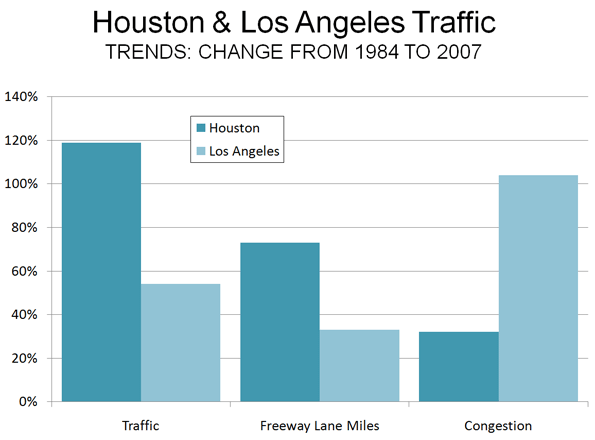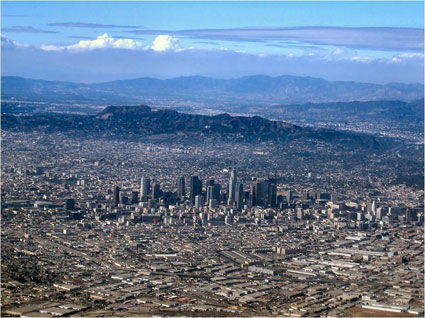Los Angeles area transit officials celebrated 20 years of urban rail at a Staples Center event on July 23. Over the past 20 years, Los Angeles has opened 2 metro (subway) lines, 4 light rail lines and two exclusive busways (though apparently busways aren't worth celebrating). Surely, there is no question but that Los Angeles has been successful in opening a lot of new transit infrastructure.
At the same time, however, The Los Angeles Times reported that Professor James Moore of the University of Southern California, blames the disproportionate financial attention paid to rail projects reduced transit ridership by 1.5 billion (with a "b") over the same period. The reason is, as Tom Rubin put it, is that many more people can be carried for the same money on buses, "Had they run a lot of buses at low fares, they could have doubled the number of riders." Rubin was chief financial officer of the Southern California Rapid Transit District, one of the two predecessors of the present transit agency (MTA). The other was the Los Angeles County Transportation Commission, to which I was appointed to three terms.
Transportation experts were also quoted to the effect that the rail system has done little to reduce traffic congestion or increase the use of mass transit much beyond the level in 1985, when planning for the Metro Blue Line began. Indeed. Traffic congestion has gotten much worse, and traffic volumes have increased materially. Our recent article showed that transit market shares had declined.
These results are in stark contrast to Houston, which in 1984 had the worst traffic congestion in the nation. Houston set about to solve the problem by expanding its roadway capacity. Since 1984, Houston's traffic grew twice as fast as that of Los Angeles, and population grew three times as fast (at least in part because many Californians were moving to Texas). Houston also added freeway mileage at double the percentage rate of Los Angeles. The reward was an increase in traffic congestion less than one-third that of Los Angeles (Figure). The most recent INRIX Scorecard shows Los Angeles traffic congestion to be more than 2.5 times as intense as Houston's.

Spending money on the right things makes a big difference. One can only wonder how different things might have been if Los Angeles had invested in the capacity people need (more roads) rather than in politically correct transit facilities that have no potential to reduce traffic congestion or to improve mobility and economic performance.
 There is a lesson from Los Angeles experience both for other areas and other government functions. The test of government performance is outputs, not inputs. Thus, it is appropriate to celebrate large transit market share increases or significant improvements in student achievement, not how many miles of rail are built or how much money is spent on education.
There is a lesson from Los Angeles experience both for other areas and other government functions. The test of government performance is outputs, not inputs. Thus, it is appropriate to celebrate large transit market share increases or significant improvements in student achievement, not how many miles of rail are built or how much money is spent on education.
Photograph: Los Angeles and the San Fernando Valley (by the author)













rail vs roads
What makes rail more "glamourous" vs the more useable roads for urban planners? Is it just the control they would have over people vs the freedom of the auto? Seems like it.
For many years, "planners" told people in my area, (NW Indiana) that adding lanes to the Borman expressway (interstate 80-94) would only create MORE traffic. Never mind that the expressway was already far beyond capacity as it was, let alone the future. Traffic congestion was far more then just rush hours.
Finally the "planners" were ignored and the expressway was expanded! Now congestion is rare. There is now four lanes in each direction and flyovers on every interchange. Its nonsense to say you cannot build your way out of congestion. When that idea was planted in "planners" heads I don't know, but it needs to go. It has only made things worse in so many places in the US by giving up on building new roads. This expansion should have been built 15 years ago.
There is now finally serious talk about building another interstate in the south part of the county since the Borman is now landlocked. Traffic will one day fill the bigger Borman (note to planners, its going to increase even if you don't build anything). Will the "planners" and eco-nuts block this project long enough to recreate the congestion?
"Planners" in NW Indiana are far more interested in the South shore railroad expansion then roads even now. Never mind even the best projections show the South Shore serving a small fraction that the new interstate would serve, they think that should be done first. Why are we as taxpayer employing these people? They need to plan for what we need not what they want.